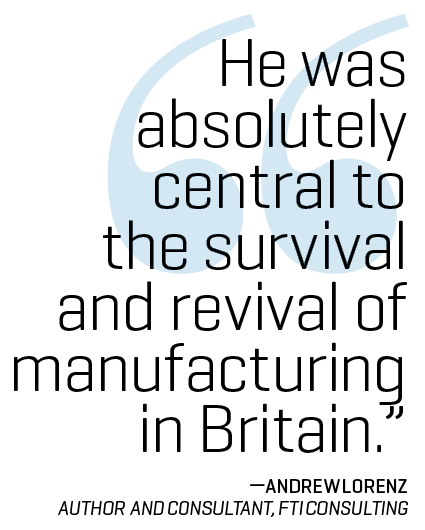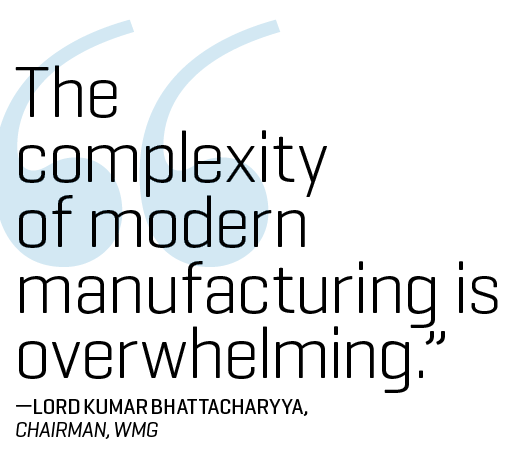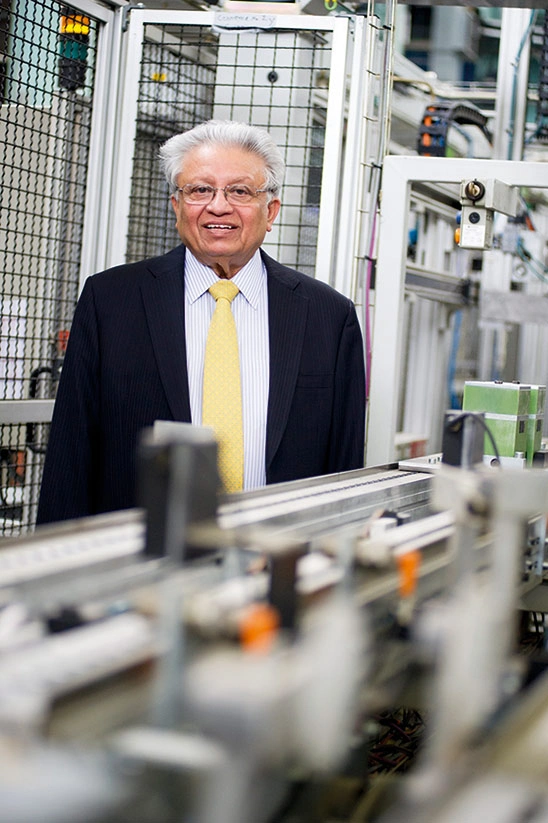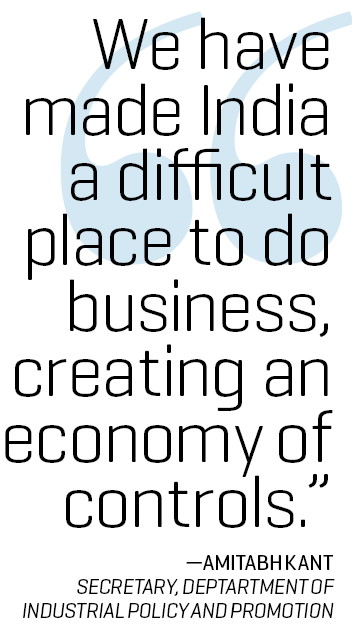In december 2012, an all-star gathering took the stage at Kolkata’s Science City to hold forth on the theme “Excel. Transform. Sustain: Building a Developed India”. It had been assembled by PanIIT—the powerful alumni body of the Indian Institutes of Technology—and headlined by Infosys founder N.R. Narayana Murthy, Tata Sons director R. Gopalakrishnan, then Goa chief minister and current union defence minister Manohar Parrikar, former U.S. ambassador to India Nancy Powell, ITC chairman Y.C. Deveshwar, and then soon-to-be Delhi chief minister Arvind Kejriwal. You would be forgiven for not noticing that the diminutive 72-year-old Baron of Moseley, and a Member of the House of Lords, was also in the auditorium.
But then, Lord Kumar Bhattacharyya, born in Dhaka in then undivided India, doesn’t have time for such trivialities. He has many of these worthies on speed dial, and is on first-name terms with heads of states.

In 2002, Bhattacharyya was awarded the Padma Bhushan, India’s third-highest civilian honour. But that has done little to make his name more widely recognisable in this country. In fact, even those in the auto industry—Bhattacharyya’s prime playing field—sometimes admit ignorance. For instance, Wilfried Aulbur, managing partner of consultancy Roland Berger and former managing director of Mercedes-Benz India, comes up blank when I quiz him about Bhattacharyya.
Meanwhile, almost every friend, acquaintance, and media feature about Bhattacharya speaks of him as the man who saved British industry. Fellow India-born peer, Lord Meghnad Desai, says: “I know him more as a friend in the House of Lords, but there is no doubt about his vital work in reviving British manufacturing.” Andrew Lorenz, senior managing director, strategic communications, at global business advisory FTI Consulting, and author of five books on business in Britain, including one on Bhattacharyya, seconds that. “He was absolutely central to the survival and revival of manufacturing in Britain,” Lorenz says.
That’s history. What about today? Can mastery over manufacturing be as precious a calling card as it was in the mid-1900s? After all, this is, as Bhattacharyya himself says in a speech, the age of the third industrial revolution: the 3D printing age. But consider this. In India alone, of the 500 largest midsize companies (which make up the Fortune India Next 500), 400 are in manufacturing, accounting for 80.3% of the group’s total revenue.
The government too has been pushing for more manufacturing out of India, and Prime Minister Narendra Modi’s trophy Make in India programme is all about doing to India what British Prime Minister Margaret Thatcher did in the 1970s and ’80s to that country. That’s why India needs more of Bhattacharyya, with his messianic image and unshakeable belief that manufacturing will always be the backbone of the economy. “India can’t be known only for its IT prowess,” he said, quietly, at the Kolkata event, addressing a hall full of engineers.
If Chandrajit Banerjee, director-general, Confederation of Indian Industry (CII), has his way, we may get to see more of Bhattacharyya. Banerjee says CII is exploring “how Indian companies can tap into Bhattacharyya’s expertise to take the Make in India mission forward”. Venu Srinivasan, chairman and managing director of auto major TVS, and a former CII president, adds that Bhattacharyya “is exactly what we need to reshape manufacturing in the country”.
BHATTACHARYYA GRADUATED from the Indian Institute of Technology, Kharagpur, and moved to Britain in the early 1960s as an apprentice at Lucas Industries in Birmingham, then a bellwether in manufacturing auto and aerospace components. A two-year apprenticeship showed Lucas what he was capable of, and Bhattacharyya was soon on the management track. He moved on from there to academia, which is where he realised that shop floor experience with an academic overlay was a huge advantage.

At the time, hardcore manufacturing firms rarely wanted university graduates outside of management, because they felt that these students were not trained to tackle “real” problems. Universities, meanwhile, preferred to stick to the ivory tower. Enter Bhattacharyya, with his idea of starting a programme that would combine practical knowhow with textbook grounding.
Talking to me on the phone from Britain 40 years later, Bhattacharyya still remembers the several opponents to his idea. “People thought it was just a money-making scheme,” he says. Universities were, largely, sceptical about the idea, not wanting to produce students who were hybrids of engineers and business graduates, and definitely not wanting close interaction with industry. The University of Warwick, under then vice chancellor Jack Butterworth (later Lord Butterworth), was willing to give space to Bhattacharyya, and in 1980, the Warwick Manufacturing Group (now WMG) was born. And with it was born Britain’s new industrial revolution, if you will.
It didn’t come a day too soon. By the 1970s, Britain was struggling to keep its place in the world order. Japan was honing its manufacturing skills, and Europe was fast rising as a strong rival. As heavy industries closed, unemployment touched its peak of 3 million in 1984. Nowhere was the rot felt more acutely than in the auto industry. Car production collapsed to 888,000 in 1982 from its peak of 1.9 million a decade ago, and British Leyland, an iconic auto brand, disappeared altogether.
Bhattacharyya’s idea, to use a phrase he has used in the past, was to help British manufacturing recover from “paralysis by analysis”. Rather than focussing on making products the best way, manufacturers were being exhorted to be good managers. With WMG, he turned the tide. His formula: Produce a versatile workforce that can make a good product and sell it too.
By the time WMG was a few years old, Bhattacharyya had helped an ailing Rolls-Royce get back in shape. But the intervention that would get him the most plaudits was directing new investment into Jaguar Land Rover (JLR).

Although JLR’s parentage had been passed on to Ford, an American company, it has always been seen as a quintessential British brand. When Bhattacharyya heard that the marquee brand was in distress and up for sale, he turned to friend Rata Tata, telling him it could be Tata Motors’ big opportunity to expand. He says he took Tata around the Jaguar facilities. Tata was impressed enough to put in a bid. “Tata understands automotive technology from all over the world. It did not take him long to gauge the benefits of JLR,” says Bhattacharyya.
The benefits were not limited to Jaguar and Tata Motors. Lorenz says: “When the western world was shrinking its manufacturing investments, thanks to high oil prices and a financial cutback, Bhattacharyya’s friendship with Ratan Tata and bringing him to invest in JLR can be seen as the turning point for British manufacturing.”
Sylvain Bilaine, managing director of boutique auto consulting firm Sy.B Consulting India, adds that the JLR deal threw a lifeline to Britain. “The investment from Tata in JLR, the currency devaluation compared to the euro, and a strong quantitative easing plan by the British exchequer” helped in an “impressive” turnaround, he says.
Over the next few years, WMG had established tie-ups with the likes of Airbus, AstraZeneca, BAE Systems, GlaxoSmithKline, Network Rail, and Siemens, apart from Rolls-Royce and JLR and a bunch of other global manufacturing companies.
Bhattacharyya had his share of influential backers, including Thatcher. She inaugurated his first centre, and visited WMG three times when in power. As Thatcher’s economic ideas became clear, and as she set about privatising British companies, Bhattacharyya’s mandate quickly expanded to improving the productivity of firms in automobile and aerospace, to attracting inbound investment.
By 2002, the year he got the Padma Bhushan, Bhattacharyya was quite the legend. That year, Simon Caulkin, writing in The Guardian, said: “If there is one man who, more than anyone else, has ensured that the U.K. has a manufacturing sector for the buck to stop at, it’s the outspoken professor Kumar Bhattacharyya, the begetter and head of Warwick University’s Warwick Manufacturing Group.”
Although investments in automobiles and ancillaries dipped after the global financial crisis in 2008, Britain’s manufacturing saw big investment announcements starting 2011. That year, car companies together announced investments of over $7 billion (Rs 44,219 crore). Leading that was JLR, which planned to invest $5 billion over five years to boost production of Jaguar and Land Rover vehicles, and buy $2 billion worth of parts from ancillaries. Honda and BMW were investing close to $1 billion, with the rest coming from a clutch of companies, including China’s state-owned SAIC Motors, which was restarting mass production of Rover cars. Read this in conjunction with the data put together by the Financial Times, which estimates that car production in Britain will touch 2.1 million by 2017, achieving its earlier peak after more than four decades, as a result of a new fervour in manufacturing investments.
“It is not just car manufacturing that has taken off in Britain. There is an entire high-quality engineering ecosystem that has come up around Coventry, making it a magnet for manufacturing investments,” says Srinivasan of TVS. And that’s largely thanks to WMG, which made the area a hotspot for automobile engineers.
Tim Leverton, who heads Tata Motors, says, “When you work with vendors to improve technology, you are actually buying into a partnership to commit to their long-term revenue stream. But the advantage of working with WMG is that the technology will eventually belong to you.”

Today, WMG runs several programmes with Tata Motors, Tata Steel, and JLR within its campus. JLR is further investing nearly £45 million (Rs 443 crore) in the National Automotive Innovation Campus, a joint venture with WMG and Tata Motors. The campus is a research centre under the University of Warwick, and will focus on automobile innovation, including self-drive cars and new, fuel-efficient propulsion systems.
WMG’s work now also includes material science, health-care devices, electronic sensors and signals, software for automation in vehicles and products, and logistics. To ensure that Britain’s youth continue to have a future in manufacturing, it is building an academy in Solihull that will train 640 British students aged 14 to 19 to enable them to apprentice in manufacturing companies. They can continue with education after gaining shop-floor experience.
“The key is to train them to be adaptive and have a multidisciplinary approach at a young age, so that they can keep pace with changes in consumer demand,” says Bhattacharyya. “When you design a washing machine today, you have to also think of the servicing aspect, which takes the business beyond manufacturing.”
In India, Bhattacharyya’s influence extends far beyond Ratan Tata. Whenever I meet the bosses of companies such as Bharat Forge, Tata Motors, or TVS, his is a name they all mention. Indeed, as I find out, Srinivasan and Leverton were both Bhattacharyya’s students at some point. (TVS had a joint venture with Lucas Automobiles, Bhattacharyya’s first employers. In fact, the peer’s home in Birmingham was once the Lucas training centre.)
Rajiv Bajaj, scion of Bajaj Auto, is another WMG product. During his engineering college days, Bajaj spent a year interning at Tata Motors and a year at Bajaj. Then he went on to do a course at WMG. “Here I thought that I had just worked in two of India’s best manufacturing firms, but what I saw at WMG blew my mind: I had so much to unlearn and learn,” he says.
Bajaj, whose father Rahul Bajaj had engaged WMG in the mid-’80s to rework his manufacturing scheduling at the scooter plant in Akurdi, says Bhattacharyya was always ahead of the curve. He says it was at WMG that he first understood how to use astute strategy to align manufacturing. Says Bajaj: “As a 22-year-old student, I understood only so much of what strategy meant. But [at WMG] it became ingrained in me that strategy [was core].”
Bhattacharyya may well be the CEO whisperer for the Indian auto sector, but that alone isn’t going to get more manufacturing here. The first step to rev up India’s factories is to improve the quality of manufacturing.
Bhattacharyya has already had an influence on that. In 2013, TVS launched its scooter brand Jupiter, which became a runaway hit. On the back of this, last year TVS’s scooter sales increased 89%, helping it overtake erstwhile joint venture partner Suzuki to become India’s third-largest scooter maker. “You can credit the success of Jupiter to all that professor Bhattacharyya has taught us over the years,” says Srinivasan. Automobile expert Adil Jal Darukhanawala, who heads the industry-focussed media platform Zeegnition, adds: “Jupiter can give even the Japanese a run for their money.”
For continuous improvement in manufacturing, there are the WMG-affiliated courses offered in partnership with CII. “India’s share in global manufacturing is just about 3%. There needs to be a concerted effort to train and mobilise good engineering talent if the country is to grow its manufacturing base,” says CII’s Banerjee. (CII is also partnering other organisations, such as Japan International Cooperation Agency (JICA). The JICA course has trained nearly 1,000 graduates in Japanese manufacturing techniques.)
Equally important, says Banerjee, is WMG’s 14-19 programme at Solihull. “CII is keenly interested in including curriculum about manufacturing in schools and early college at the moment. We want to get more people not think that manufacturing is dirtying your hands, and create a good alternative to IT jobs.”
Which brings us to Make in India. The year-old scheme focusses on job creation and skill enhancement by getting global manufacturing to move to India. Delivering the convocation speech at his alma mater IIT Kharagpur recently, Bhattacharyya said he agrees with Modi’s vision. “Like the Prime Minister, I believe the key to India’s future is a massive expansion of manufacturing. It will be through your intellectual prowess and technical innovation that the potential of Make in India will be realised.”
Then, crucially, he said that manufacturing itself had changed. “The complexity of modern manufacturing is overwhelming,” he said, going on to explain that modern manufacturing was “so multidisciplinary, it requires vast scale”.
On its part, the government seems to acknowledge that it has not been a force for good in this space. “Over the last 60 years, we have made India a difficult place to do business. We have simply created an economy of controls,” says Amitabh Kant, secretary, Department of Industrial Policy and Promotion, the government body that’s running Make in India. Industry bodies such as CII are doing their bit to lure minds like Bhattacharyya’s back. It’s a start, sure, but as Bhattacharyya himself tells me philosophically, “the road to good manufacturing cannot be laid overnight”.










Leave a Comment
Your email address will not be published. Required field are marked*